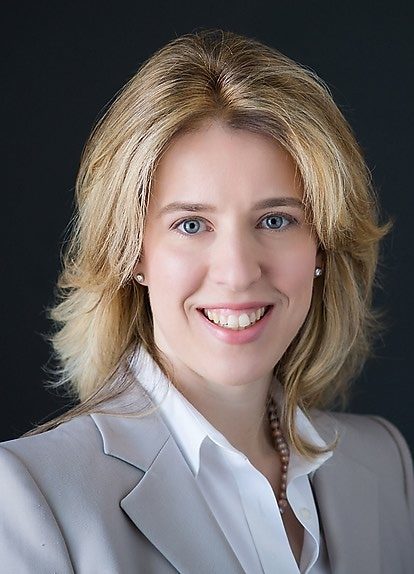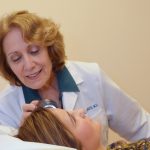When a bump on the eyelid is cancerous, a patient usually requires surgery to have it removed, which leaves behind a hole. Oculoplastic surgeons like Natalie Wolkow, MD, PhD, rely on specialized surgical techniques to reconstruct the eyelid to ensure the health of the eye and to leave it looking as cosmetically normal as possible.
Natalie from Wellesley, MA, was at her dermatologist’s office for a routine appointment last summer when the physician’s assistant (PA) raised concern about a bump on her eyelid. Despite having this bump for years and not thinking much of it, the PA suggested that she get it biopsied.
“This thing on my eye, various dermatologists had looked at it for years and said nothing,” Natalie recalled to Focus.
Unbeknownst to many, the eyelid is a common site for skin cancer, but the problem can be difficult to detect at first. Or, in cases like Natalie’s, easy to ignore.
A person might notice a small bump or a little red spot on their eyelid, or there could be subtle changes like a few missing eyelashes.
“If you notice something out of the ordinary on the eyelid, such as a new bump, a patch that’s changing in color, a scab that won’t heal or an area where there are eyelashes missing, schedule an appointment with your eye doctor, “ advised Natalie Wolkow, MD, PhD, a member of the Ophthalmic Plastic Surgery Service and the Ophthalmic Pathology Service at Mass Eye and Ear. “Make sure that someone takes a look at it, because there is a chance that it might need to be biopsied.”
If the biopsy results reveal cancer, which is most often basal cell carcinoma but sometimes can be squamous cell carcinoma or melanoma on the eyelid, treatment is necessary to stop the cancer’s spread and to protect the health of the eye and surrounding areas.
Typically, a patient with skin cancer on their eyelid will be referred to a Mohs surgeon for removal of the cancer. Mohs surgery is a technique used to remove cancer cells while preserving as much healthy skin as possible. Surgeons performing this procedure remove a small amount of skin at a time and immediately examine it under a microscope, repeating the process until no additional cancer cells are detected.
After the cancer is removed, the patient is left with a hole in the eyelid that can look a bit jagged, explained Dr. Wolkow. If not repaired, that part of the eyelid would be missing permanently, leading not only to a cosmetic problem, but also health problems for the eye.
Eyelids are very important to the health of the eye. Although they seem simple, they are actually rather complex. They are made up of skin on the outside, muscles that open and close the eyelids on the inside, and they are lined by a smooth but stiff moist surface that glides on the surface of the eyeball without scratching it. The openings of the tear drainage system are embedded in the eyelids. For the eye to feel comfortable and the eyelids to work normally, all of these components need to be working properly. In reconstructing the eyelid, each of these parts need to be considered. That’s where an oculoplastic surgeon, who is a specialist focusing on the eyelids and tissues and structures around the eye, is the ideal person to reconstruct the eyelid.
“In treating eyelid cancers we have three goals. Our primary goal is to remove the cancer. Our next goal is to reconstruct the eyelid to make sure that the eye is functioning normally, and that vision and the health of the eye are preserved,” said Dr. Wolkow. “And our third goal is to cosmetically make the eye look as normal as possible.”

The “artistry” of eyelid reconstruction
Oculoplastic surgeons are subspecialist ophthalmologists who have undergone several years of extra training in eyelid, orbital, periocular and tear duct surgery and reconstruction. They are uniquely positioned to perform eyelid reconstruction given their understanding of the eye, eyelid anatomy, the tear drainage system and what an eyeball requires to have a healthy environment.
“There are several ways to reconstruct an eyelid depending on what the defect looks like and which tissues are available to borrow from other locations,” said Dr. Wolkow. “There’s quite a bit of artistry that comes in with oculoplastic surgery. Every patient is unique.”
There is an array of surgical flap techniques and many options for skin grafts from different locations that oculoplastic surgeons can utilize to successfully reconstruct an eyelid. For example, the surgeon might be able to slide adjacent eyelid skin over or borrow tissues from the underside of the upper eyelid or turn to a skin graft from a different eyelid. Other times, skin can be taken from behind the ear or from the collarbone area. Less commonly, smooth tissue can be taken from inside the mouth to line the inner surface of an eyelid.
Surgeons take into consideration the size and location of the hole, whether it involves the entire thickness of the eyelid or just a portion of it, the patient’s skin type, whether the tear duct system is involved, the patient’s visual function and what tissues are available for borrowing when designing a surgical plan. Sometimes a case is not very straightforward, such as if the patient has previously had other skin cancers removed from the face, or in some situations if they’ve had previous cosmetic facial surgeries. The previous surgeries can leave their skin tight elsewhere in the face, so there is not much excess skin left to borrow.
“Cosmetically, we try our best to match skin type and thickness from one location with another. The eyelid skin is very thin and different from skin in other areas of the face,” said Dr Wolkow. Eyelids can also shrink down and scar in specific ways as they heal, which the surgeon also compensates for. If tear ducts are involved, they may need to be reconstructed with a temporary stent. “Being cognizant of these things results in a better functional reconstruction and a more satisfied patient,” she said.
Eyelid reconstructions can yield excellent results
Natalie S. knew she needed a biopsy but didn’t want just any eye doctor to handle it, so she turned to Mass Eye and Ear. She found Dr. Wolkow online –the kismet of them sharing the same first name helped her feel at ease with her choice. Dr. Wolkow biopsied the bump right away, and the results came back positive for cancer cells. Natalie was referred for Mohs surgery at Mass Eye and Ear where the cancer was removed. That same day, Dr. Wolkow performed a surgical reconstruction of the eyelid. In the days and months since the surgery, Natalie has been satisfied with the results and her care experience.
“At first I thought I looked like the son of Frankenstein,” she joked, “but within several weeks I was totally healed.”

Judy from Belfast, Maine, was already an established patient at Mass Eye and Ear for complex cataract surgery when she was subsequently diagnosed with glaucoma. She was then referred to a glaucoma specialist at Mass Eye and Ear, who noticed a bump on her eyelid, and referred her to Dr. Wolkow. Dr. Wolkow performed a biopsy, and the results came back as basal cell carcinoma, prompting Judy to undergo surgery this June.
“They were able to schedule my Mohs surgery in the morning, and then I walked upstairs and Dr. Wolkow put everything back together,” she said.
Judy described the surgery as painless and was pleasantly surprised she didn’t experience any symptoms in her early days of healing.
“I went on right with my life,” she said. “I was very fortunate to have gone to Mass Eye and Ear and Dr. Wolkow, the care has been extraordinary.”
About our expert
 Natalie Wolkow, MD, PhD, is a member of the Ophthalmic Plastic Surgery Service and the Ophthalmic Pathology Service at Mass Eye and Ear. She sees patients with diseases of the orbit, eyelids, and lacrimal system, and also reviews pathology slides in the laboratory. Dr. Wolkow specializes in the surgical treatment of orbital and eyelid cancers, tear drainage system dysfunction, reconstructive surgery, orbital fractures, traumatic lacerations, thyroid eye disease and orbital inflammation. She performs cosmetic eyelid and eyebrow lift surgery, as well as cosmetic injections, such as Botox. Dr. Wolkow sees patients at the Main Campus and Longwood practice, both in Boston.
Natalie Wolkow, MD, PhD, is a member of the Ophthalmic Plastic Surgery Service and the Ophthalmic Pathology Service at Mass Eye and Ear. She sees patients with diseases of the orbit, eyelids, and lacrimal system, and also reviews pathology slides in the laboratory. Dr. Wolkow specializes in the surgical treatment of orbital and eyelid cancers, tear drainage system dysfunction, reconstructive surgery, orbital fractures, traumatic lacerations, thyroid eye disease and orbital inflammation. She performs cosmetic eyelid and eyebrow lift surgery, as well as cosmetic injections, such as Botox. Dr. Wolkow sees patients at the Main Campus and Longwood practice, both in Boston.


I need to see an Oculoplastic surgeons ASAP . I was diagnosed with (MG ) Myasthenia Graves , and need surgery for both lower and upper lids for both eyes.
Please I badly need your help Thanks
Hi Zuhair, to arrange an appointment with a Mass Eye and Ear oculoplastic surgeon, please call 617-573-3202. Here’s more information on that service: https://www.masseyeandear.org/specialties/eye-plastics